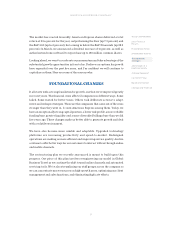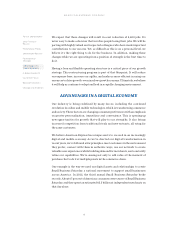American Express 2012 Annual Report Download - page 19
Download and view the complete annual report
Please find page 19 of the 2012 American Express annual report below. You can navigate through the pages in the report by either clicking on the pages listed below, or by using the keyword search tool below to find specific information within the annual report.AMERICAN EXPRESS COMPANY
2012 FINANCIAL REVIEW
financial measures may differ from the calculations of similarly
titled measures by other companies.
BANK HOLDING COMPANY
The Company is a bank holding company under the Bank
Holding Company Act of 1956 and the Federal Reserve Board
(Federal Reserve) is the Company’s primary federal regulator. As
such, the Company is subject to the Federal Reserve’s
regulations, policies and minimum capital standards.
CURRENT ECONOMIC ENVIRONMENT/OUTLOOK
The Company’s results for 2012 continued to reflect strong
spending growth and credit performance in both the United
States and internationally. The rate of growth was, however,
slower than in the prior year, reflecting in part the impact of a
challenging global economic environment. The Company also
saw its average loans continue to grow modestly year over year,
leading to a 6 percent growth in net interest income while
lending loss rates are near all-time lows.
The positive impacts of strong billings and loan growth were
offset by lower lending reserve releases this year as compared to
the prior year, and three charges taken in the fourth quarter of
2012, related to restructuring of $400 million, Membership
Rewards estimation process enhancements of $342 million and
cardmember reimbursements of $153 million, in addition to
amounts incurred in prior quarters during the year. In 2010 and
2011 the Company saw operating expenses increase as a result of
its strategy to invest in the business in light of the favorable
impacts of lending reserve releases and the settlement proceeds
from Visa and MasterCard. In 2012, the Company’s objective
was to grow operating expenses at a slower pace than revenue
growth. Adjusting for the fourth quarter restructuring charge, as
well as the Visa and MasterCard settlement payments recognized
in 2011, the Company was successful in achieving this objective.
The Company believes the restructuring charge taken in the
fourth quarter will help to make its cost structure leaner and
more efficient. The Company’s aim is to grow operating expenses
at an annual rate of less than 3 percent in both 2013 and 2014,
with the 2012 operating expenses, excluding the restructuring
charge, as the base. The Company will seek to invest in growth
opportunities in the United States and internationally and will
aim to keep marketing and promotion expenses at approximately
9 percent of revenues.
The Company recognized a $342 million charge in the fourth
quarter reflecting enhancements to the process that estimates
redemptions of Membership Rewards points by U.S.
cardmembers. In particular, the changes increased the global
Ultimate Redemption Rate (URR) by approximately 100 basis
points, resulting in a URR of 94 percent, representing the
estimate of the amount of earned points that will ultimately be
redeemed by cardmembers.
The regulatory environment continues to evolve and has
heightened the focus that all financial companies, including the
Company, must have on their controls and processes. Additional
regulation, increased compliance efforts and enhanced
regulatory enforcement had an impact on the Company. The
review of products and practices will be a continuing focus of
regulators, as well as by the Company.
Competition remains extremely intense across the Company’s
businesses. In addition, the global economic environment
remains uneven. While the Company’s business is diversified,
including the corporate card business, a large international
business and GNS partners around the world, any impact of
potential U.S. income tax law changes and continued budget and
debt ceiling discussions in Washington remains uncertain. In
addition, the current instability in Europe could further
adversely affect global economic conditions, including continued
pressure on consumer and corporate confidence and spending,
and cause disruptions of the debt, equity and foreign exchange
markets. Europe accounted for approximately 11 percent of the
Company’s total billed business for the year ended December 31,
2012.
RESTRUCTURING INITIATIVES
The Company recently committed to undertake a companywide
restructuring plan designed to contain future operating expenses,
adapt parts of the business as more customers transact online or
through mobile channels, and provide the resources for
additional growth initiatives in the United States and
internationally. The charges relating to the plan total
approximately $400 million pre-tax (approximately $287 million
after-tax), which the Company recognized in the fourth quarter
of 2012. The total charges include approximately $370 million
pre-tax (approximately $265 million after-tax) in employee
severance obligations and other employee-related costs.
A major portion of the restructuring plan involves
reengineering the Company’s model in its Global Business Travel
group as the Company continues the shift toward online
channels and automated servicing tools. It will also include
streamlining its staff groups to concentrate more resources in
high-growth areas, optimizing the Company’s client
management and eliminating duplicate efforts, while continuing
to maintain the right focus and resources on risk and control
activities. The restructuring is expected to result in the
elimination of approximately 5,400 jobs in the aggregate. Those
reductions are expected to be partly offset by jobs the Company
anticipates to add during the year. Overall staffing levels by year-
end 2013 are expected to be 4 to 6 percent less than the current
total of 63,500. The restructuring plan is expected to be
substantially completed by the end of 2013. The Company
estimates that substantially all of the costs will result in future
cash expenditures.
17
























